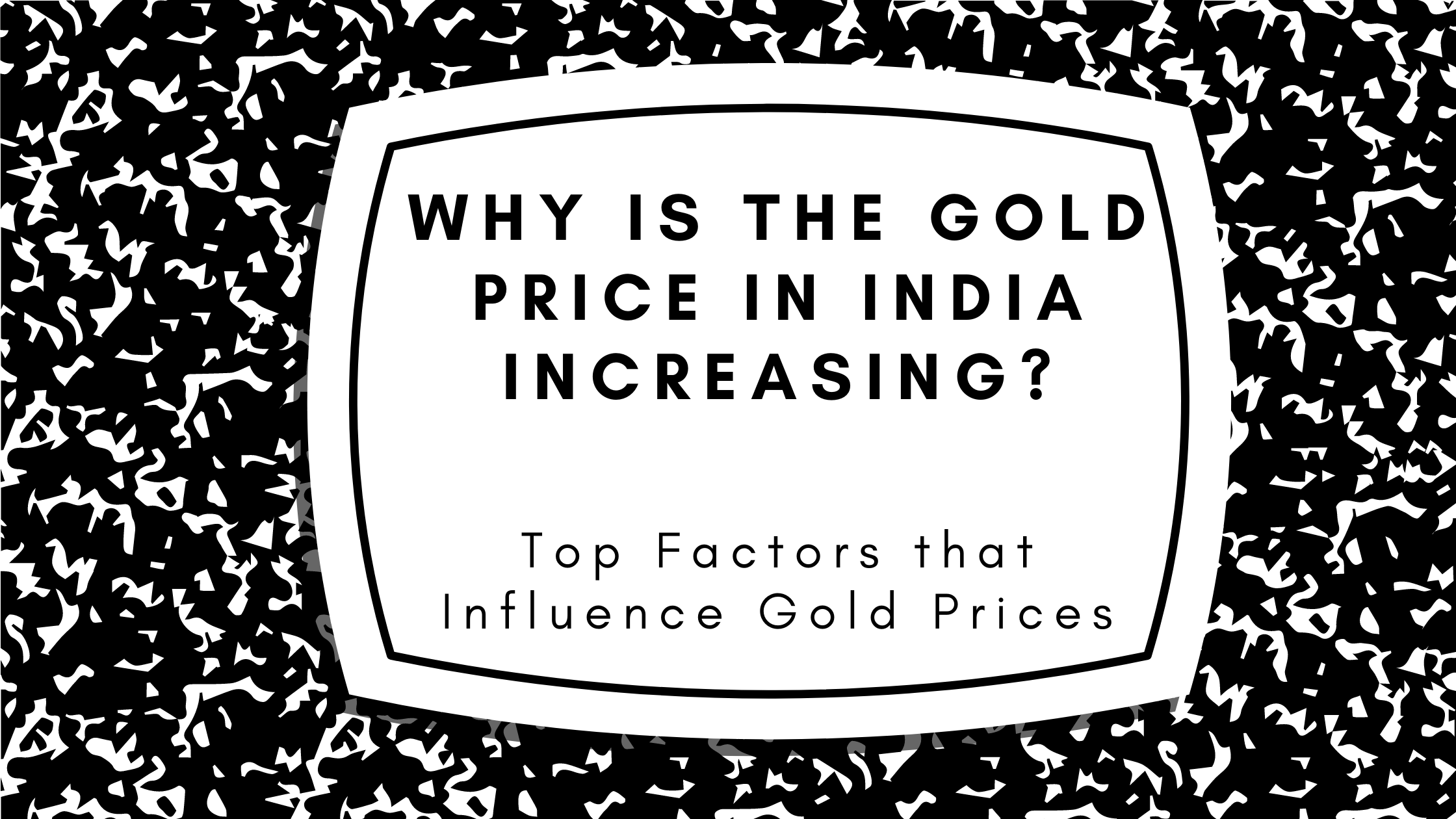Gold has long been considered one of the most classic investment options. Buying gold was one of the most popular investing methods before we learned about fixed deposits, stock markets, and mutual funds. Gold has traditionally been regarded as a valuable monetary asset throughout the world. It is seen as a symbol of prosperity and status among Indians.
Due to the metal’s scarcity, gold has evolved into a suitable hedge for unpredictable markets through time. Since we have seen a constant increase in the gold price in India it is considered to be one of the most popular investment options in India. Gold has long been seen as a secure investment that will aid in the recovery of any financial crisis. Today the gold rate in India doesn’t affect the willingness of Indians to buy gold.
In this article let us look into the aspects that determine the gold rate in India and the factors that influence it.
What is Causing the Rise in Gold Prices in India?
To combat the spread of COVID-19, most countries have implemented nationwide lockdowns from March 2020. While this helped to restrict the spread of the disease, it also created many economic upheavals because businesses were closed and imports and exports were cancelled. While the government launched a slew of economic packages to help people get through these difficult times, interest rates fell, and many investors began to steer clear of riskier assets. As a result, the gold rate in India rose significantly.
As the lockdowns were removed and businesses resumed operations, investors thought that the economy would swiftly rebound. As a result, a large number of investors began purchasing undervalued, high-quality companies. However, when expectations for a near-term recovery faded, investors began looking for a haven for their money. Gold demand has surged as a result of its reputation as an ideal hedge against inflation and economic turbulence. This led to the rise in gold prices in India.
Some of the other factors are as follows:
High Liquidity
The government announced a slew of economic stimulus initiatives to bolster market liquidity. So, investors had money to invest, but the stock markets were extremely unpredictable, and interest rates were plummeting. As a result, they began investing in gold, which is believed to be a secure investment in such circumstances.
Reduced Gold Mining
The demand and supply relationship is the most important element that influences gold prices in India. While demand grew, gold mining operations were severely hampered by lockdowns in several countries. As a result, supply was disrupted, causing prices to soar even higher.
Exchange Rate
Since the lockdown, the Indian Rupee has plummeted. It is now trading at roughly 75 cents per dollar against the US currency. Because India is the world’s second-largest gold importer, currency rate movements have an impact on the gold rate in India.
Rise in International Gold Prices
The international price of gold has an impact on the gold prices in India. Gold prices have been steadily rising around the world as the global economy has slowed.
What Factors Influence Gold Prices in India?
In India, gold demand is intertwined with culture, tradition, a desire for beauty, and financial security. Several factors influence the price of gold. Let’s have a look at some of the criteria below:
Demand and Supply
The demand and supply of gold, as with any traded commodity, play a significant impact in determining its price. Gold, unlike oil, is not a consumable commodity. The globe still has all of the gold that has ever been mined. In addition, the amount of gold mined each year is not particularly large. As a result, if demand for gold rises, the price rises because supply is limited.
Inflation
Indians prefer to invest in gold because the gold rate in India reacts to inflation. When inflation rises, the value of a currency falls. As a result, many choose to save their money in the form of gold. Gold functions as a hedging measure against inflationary conditions when it remains high for an extended length of time. Gold’s value is regarded as constant in the long run because the value of the currency fluctuates.
The Decision of the Central Bank
Because of the vast volume of transactions, the central bank’s choice to purchase or sell gold (in India’s instance, the Reserve Bank of India) can have an impact on its price. When the economy is booming, central banks must sell off a considerable amount of gold reserves. The gold is sold in the market, even though other institutional buyers are not interested in purchasing it. Almost every time the central bank begins to diminish its gold reserve, the gold price in India falls.
Exchange-traded funds (e.g. gold trusts and gold shares) also engage in such high-volume gold sales and purchases, and these transactions have a significant impact on gold demand and supply.
Interest Rates
According to some business analysts, gold and interest rates have a negative association under normal circumstances. The prospect of a strong economy is reflected in the rising yield. Inflation is caused by a strong economy, and gold is used as a hedge against inflation. In addition, as interest rates rise, investors flock to fixed-income investments, which provide a guaranteed return, unlike gold, which does not. As a result, demand takes a back seat, and prices remain unchanged.
Good Monsoon
The demand for gold in the country, which is mostly dependent on monsoons, is influenced by rural demand. India utilizes 800-850 tonnes of gold every year, with rural India accounting for 60% of total consumption. As a result, the monsoon has a significant impact on gold consumption because if the harvest is strong, farmers would utilize their earnings to purchase gold to build assets. On the other hand, farmers tend to sell gold to raise finances when the monsoon is insufficient.
Import Duty
India’s contribution to global gold production is less than 1%. It is, nevertheless, the precious metal’s second-largest consumer. To accommodate the huge demand, it imports a lot of gold. As a result, the import duty has a significant impact on gold prices in India.
Indian Jewellery Market
Gold jewellery is extremely popular among Indians. Gold jewellery has a unique place in Indian households, whether it’s for festivals or birthdays. Gold prices in India rise throughout the wedding season, as well as during festivals like Diwali, as a result of increased consumer demand. The gold rate in India rose as a result of the demand-supply imbalance. All of these factors combine to increase gold demand in India to the point that the country must import large quantities of yellow metal regularly. The demand for gold in the industrial sector amounts to 12% of the total demand in the country.
Government Reserves
Most major countries’ central banks keep both currency and gold reserves. The Reserve Bank of India and the Federal Reserve of the United States are two outstanding instances of this. The price of gold rises as large countries’ central banks begin to retain gold reserves and purchase more gold. This is because the market’s cash flow has increased while the supply of gold has decreased.
Impact of the Rupee-Dollar Equation
While the rupee-dollar equation does not affect worldwide gold prices, it impacts Indian gold rates. Because gold is mostly imported, if the rupee falls in value versus the dollar, gold prices will likely rise in rupee terms. As a result, a weakening rupee may reduce gold demand in the country. However, keep in mind that changes in the rupee-to-dollar exchange rate do not affect gold prices priced in dollars.
Correlation with Other Assets
Due to its low to negative correlation with all major asset classes, some economists feel gold is a highly effective portfolio diversifier. Gold, on the other hand, does not have a statistically significant association with other asset types. However, some argue that there is evidence that when equities are under stress, that is, when their value is rapidly declining, gold and stocks might develop an inverse correlation.
Because the factors that affect the returns from most asset classes, both on the macro-economic and micro-economic fronts, do not have a substantial impact on the price of gold, it protects one’s portfolio against volatility.
Geopolitical Factors
Gold traditionally performs well during times of geopolitical unrest, and the current issue over North Korea’s nuclear potential has boosted the yellow metal’s chances. War, which harms other asset classes, has a positive influence on gold prices because demand for gold as a haven for depositing funds increases.
What Drives the Gold Rate in India?
Gold valuation is more difficult than asset valuation. The four categories of businesses that make up the industry deal with gold. Exploration and development, mining, consumers, and recyclers are the different types of businesses. Industrial consumers, jewellers, and investors are the three types of consumers.
The gold price in India is fixed daily. It is an agreement between market participants on the same side to purchase and sell gold at a predetermined price or to maintain market conditions to keep the price stable by managing supply and demand.
Six fundamental drivers affect gold prices. The following are the details:
- Movements in the prices of other goods, as well as demand for these items. The cost of production is priced indirectly.
- Inflation in the United States and worldwide is being driven by an increase in the money supply.
- The Central Bank’s activities include money printing, gold acquisitions, and sales.
- Trade and growth imbalances against the United States have resulted in twin deficits. This results in a fear factor.
- Inflation and wages in the United States are contrasted to real interest rates. This is followed by financial repression.
- In the form of demand and supply, using the production, demand, or inventory formula.
The demand for gold, one of the world’s most valuable commodities, is influenced by the number of gold reserves held by central banks, the value of the US dollar, and the desire to hold gold as a hedge against inflation and currency depreciation.
Why Should you Put Money into Gold?
Gold is regarded as a global benchmark of worth for currencies. Gold rises as the stock market falls. Investing in gold will allow you to maintain a healthy balance in your wealth. Gold is also a superior performer in times of economic instability, and it is referred to as a crisis commodity because of its high resilience. It serves as an inflation hedge. Any drop in the value of the dollar raises the gold rate in India.
Gold can also be used to transfer wealth to the next generation in a subtle manner. The Chinese and Indian governments’ demand for gold is helping to maintain the price of gold high.
With gold prices attracting the attention of most investors, it’s crucial to think about all of your options before jumping on board. Consider the above principles and make sure your investments are in line with your investing strategy and risk tolerance. While gold is a smart investment during these times, it comes with its own set of concerns. Before you invest, be sure you have a complete understanding of the situation.
You Might Also Like: How is the price of Gold determined in India?
FAQ
What is the maximum amount of gold that a person can own?
A married woman can keep up to 500 grams of gold jewellery, an unmarried woman up to 250 grams, and a male family member up to 100 grams of gold decorations and jewellery, according to the CBDT circular.
Is it a good time to buy gold now?
Gold can be an excellent financial item if it is part of a well-balanced portfolio. Gold has one of the most liquid commodity markets, and its value has continuously increased over time.
Is gold a better option than equities as a long-term investment?
Gold has traditionally been seen as a reliable store of value and inflation hedge. However, in the long run, both stocks and bonds have surpassed gold’s price increase on average.
What effect do the government's gold reserves have on the gold price in India?
When a central bank begins to retain gold reserves, the price of gold rises naturally because the quantity of gold falls while the cash reserve rises.
What factors influence the price of gold?
Supply and demand dictate the price of this valuable commodity, and the market price for gold is set each day using a deceptively simple procedure. Everyone in the gold sector, from miners to bankers to pawn shops, relies on the official market price of gold.
What is the relationship between inflation and gold price in India?
The price of gold is inversely proportional to inflation. This is why individuals used gold to protect themselves from inflation when the economy declined. Inflation raises the demand for gold and vice versa.
























